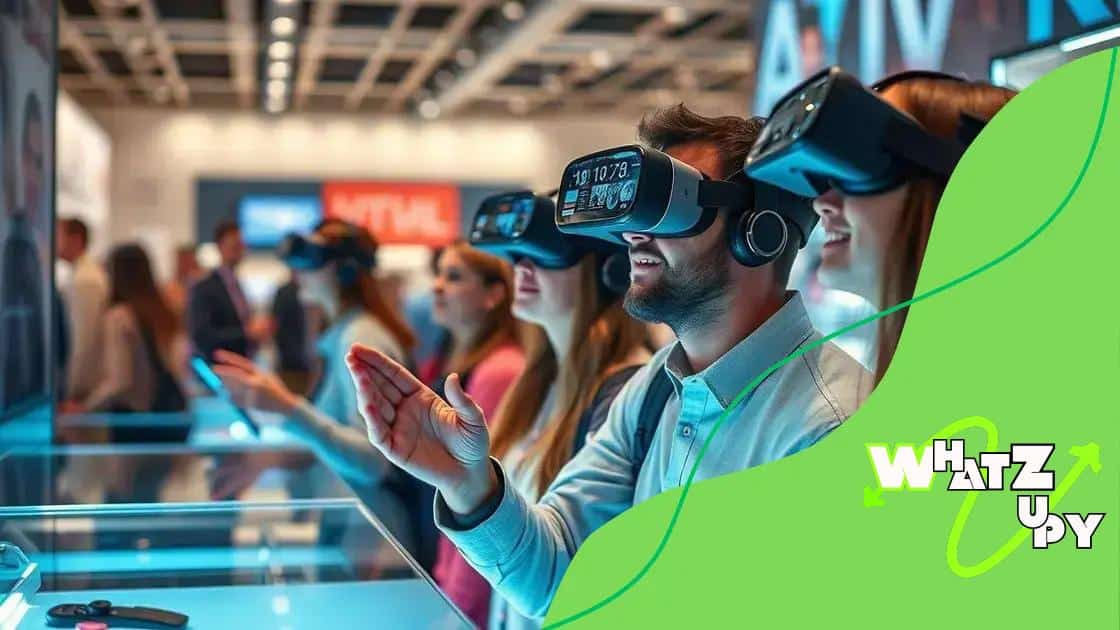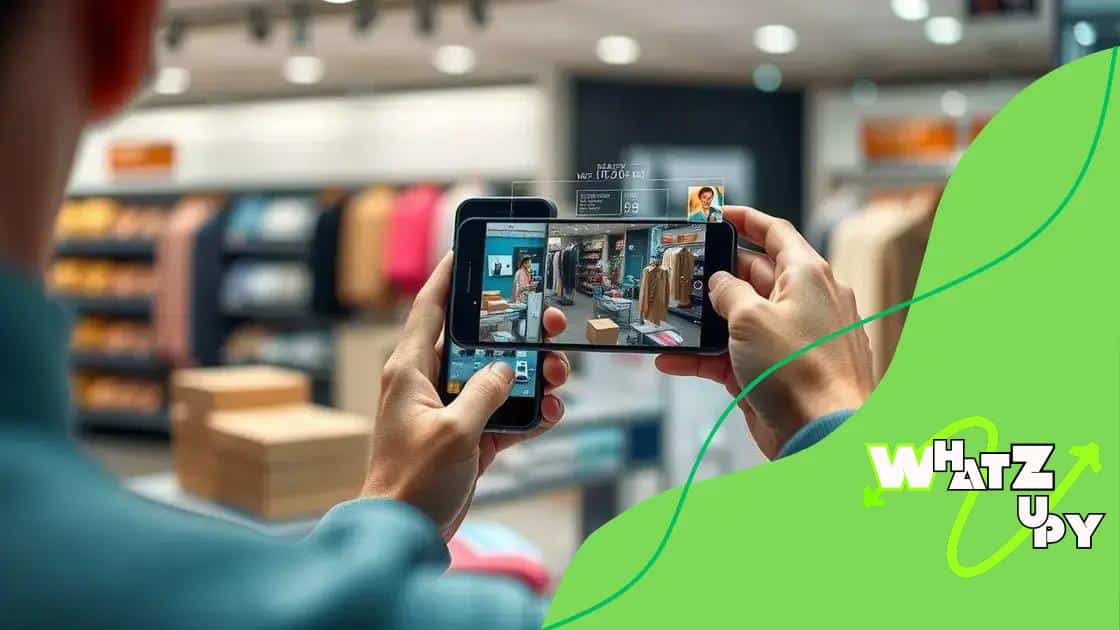Experiential marketing in virtual and augmented reality

Experiential marketing in virtual and augmented reality creates immersive experiences that engage consumers, leveraging technologies like AI and AR to enhance brand interaction and foster customer loyalty.
Experiential marketing in virtual and augmented reality offers brands an exciting avenue to engage customers in immersive ways. Have you ever thought about how these technologies change our interactions with products and services? Let’s dive in!
Understanding experiential marketing
Understanding experiential marketing involves grasping how brands engage customers through memorable experiences. It is not just about selling a product; it’s about creating an emotional connection. Experiential marketing aims to immerse consumers in a way that resonates deeply, leaving a lasting impression.
This approach taps into all the senses, making interactions more impactful. It allows consumers to experience a brand firsthand. When done effectively, it can significantly boost customer loyalty and drive sales.
Key Elements of Experiential Marketing
Several components make experiential marketing successful:
- Engagement: Creating interactive elements that draw consumers in.
- Storytelling: Sharing a compelling narrative that connects with the audience.
- Immersion: Allowing consumers to be part of the experience, rather than just spectators.
- Feedback: Gathering insights from participants to improve future experiences.
By focusing on these elements, brands can create events or campaigns that truly resonate with their audience. For instance, a pop-up event can serve as an experiential marketing opportunity, showcasing a brand’s values and products in an engaging environment.
Examples of Experiential Marketing
Numerous companies have harnessed the power of experiential marketing. Consider brands like Coca-Cola, which has used interactive vending machines that personalize experiences based on customer interactions. Such tactics not only promote products but also foster genuine connections between consumers and the brand.
Another example includes the use of augmented reality (AR) apps that help customers visualize products in their everyday lives. This modern twist on experiential marketing enhances the shopping experience, allowing for better decision-making.
As brands continue to innovate, the landscape of experiential marketing is evolving rapidly. Incorporating cutting-edge technology like virtual reality (VR) can further deepen customer engagement. By creating immersive worlds, brands can transport consumers into their narrative, enriching the overall experience.
The role of virtual reality
The role of virtual reality in experiential marketing is transformative. It offers brands a way to create immersive experiences that captivate and engage consumers. By utilizing VR, companies can transport their audience into a new world, allowing them to interact with products and services like never before.
This technology goes beyond traditional advertising methods. Virtual reality enables consumers to step into a brand’s story. Imagine trying on clothes virtually or exploring a destination through VR before booking a trip. These experiences make decision-making easier and more enjoyable.
Benefits of Virtual Reality in Marketing
Utilizing virtual reality comes with several key benefits:
- Enhanced customer engagement: Virtual reality captivates audience attention and keeps them interested.
- Realistic product demonstrations: VR allows consumers to experience products in a lifelike environment.
- Increased brand loyalty: Memorable experiences foster emotional connections, encouraging repeat business.
- Market differentiation: VR can set a brand apart from competitors by offering unique experiences.
In addition to these benefits, virtual reality can provide valuable data insights. Brands can track user interactions and preferences, refining their marketing strategies based on real-time feedback. This adaptability allows companies to remain relevant in a fast-paced digital landscape.
Examples of Virtual Reality in Action
Leading brands showcase the potential of virtual reality. For example, IKEA’s VR application lets customers visualize furniture in their own homes. Users can adjust sizes and placements before making a purchase. This not only enhances the shopping experience but also reduces the chances of returns.
Another notable example is a travel company offering virtual tours of destination resorts. Prospective travelers can explore accommodations and amenities, leading to higher bookings. Such experiences highlight how virtual reality can effectively influence consumer behavior.
The integration of virtual reality into marketing campaigns is a growing trend. As more brands recognize its power, we can expect increasingly creative and engaging uses of this technology.
How augmented reality enhances experiences

How augmented reality enhances experiences is an exciting topic in the realm of marketing. Augmented reality (AR) adds digital elements to the real world, creating an interactive experience for users. This technology allows brands to engage consumers in an innovative way that traditional marketing methods cannot.
With AR, consumers can visualize products in their environment before making a purchase. For instance, using their smartphones, customers can see how a piece of furniture looks in their own living room. This not only makes shopping more enjoyable but also helps in making more informed decisions.
Benefits of Augmented Reality
Utilizing augmented reality in marketing offers several advantages:
- Interactive experiences: AR engages users with interactive content that is immersive and fun.
- Real-time visualization: Customers can see how products fit into their lives instantly.
- Improved customer retention: Engaging experiences foster loyalty and encourage repeat business.
- Unique brand identity: AR helps companies stand out by offering something fresh and exciting.
Incorporating augmented reality can also simplify complex concepts. For example, in tech or automotive industries, AR applications can demonstrate features and functionalities in a way that traditional materials cannot. Users can interact with digital models and see how products work in real life.
Examples of Augmented Reality in Marketing
Brands like Sephora and IKEA have successfully integrated augmented reality into their marketing strategies. Sephora’s app allows users to try on makeup virtually. This not only boosts consumer confidence but also enhances the overall shopping experience.
IKEA’s Place app lets users visualize how furniture would look in their space, making it easier to choose the right pieces. Such applications demonstrate how AR can bridge the gap between online and offline shopping.
The integration of augmented reality in marketing is set to increase. As technology advances, brands will continue to find creative ways to utilize AR to enhance consumer experiences and connect with their audience better.
Case studies of successful campaigns
Case studies of successful campaigns illustrate how brands can effectively utilize experiential marketing. These examples provide insight into what works and how it can impact consumer behavior. By analyzing these campaigns, we can understand strategies that enhance engagement.
One notable case is the Pepsi Max bus shelter campaign. This innovative setup transformed a regular bus stop into an immersive experience. Using augmented reality, unsuspecting passengers were treated to unexpected and thrilling surprises, such as alien invasions and roller coaster rides. This not only captured attention but also created a buzz on social media.
Key Takeaways from Successful Campaigns
Successful campaigns often share common elements:
- Creativity: Unique concepts capture consumer interest and inspire sharing.
- Emotional connection: Campaigns that resonate emotionally foster stronger relationships with the brand.
- Social media integration: Encouraging online sharing amplifies the campaign’s reach and visibility.
- Real-time interaction: Engaging consumers in real-time enhances the overall experience.
Another impressive example is Nike‘s “The Last Da Vinci” campaign. Nike partnered with local artists to create an interactive street art project that allowed consumers to participate. This campaign enhanced community involvement and showcased Nike’s commitment to creativity and culture.
These case studies show that experiential marketing can boost brand awareness and customer loyalty. Many brands now prioritize these strategies to stand out in a competitive market. The right mix of creativity and engagement can result in success and long-lasting consumer relationships.
Future trends in experiential marketing
Future trends in experiential marketing are shaping the way brands interact with consumers. As technology evolves, brands are exploring new ways to create immersive experiences that captivate audiences. Understanding these trends can help businesses stay ahead in a competitive market.
One significant trend is the increasing use of artificial intelligence (AI) to personalize experiences. AI can analyze consumer data to offer tailored suggestions, making interactions more relevant and engaging. By understanding user preferences, brands can create experiences that resonate on a personal level.
Key Trends to Watch
Here are some trends that are likely to shape the future of experiential marketing:
- AR and VR advancements: As technology improves, expect more brands to use augmented and virtual reality to create immersive experiences.
- Increased focus on sustainability: Consumers are increasingly aware of environmental issues, driving brands to incorporate sustainable practices in their campaigns.
- Interactive elements: Enhanced interactivity using mobile apps and online platforms will foster deeper engagement with consumers.
- Integration of social media: Brands will continue to leverage social media to amplify their experiential campaigns, encouraging users to share their experiences online.
Moreover, the rise of contactless experiences is changing how consumers engage with brands. In a post-pandemic world, touchless interactions, like virtual tours and mobile payments, are becoming the norm. This shift not only enhances safety but also streamlines the customer journey.
With the growing importance of personalization, brands will need to harness data more effectively. Utilizing insights from consumer behavior will allow for more targeted marketing strategies. The future of experiential marketing is about creating deeper connections through relevant and engaging experiences.
In conclusion, experiential marketing in virtual and augmented reality is shaping how brands connect with audiences. By embracing new technologies and trends, companies can create memorable and engaging experiences that resonate with consumers. As we look to the future, the integration of AI, AR, and VR will elevate these interactions even further, driving customer loyalty and brand success. Staying ahead of these trends will be crucial in building stronger relationships with customers and standing out in a competitive market.
FAQ – Frequently Asked Questions about Experiential Marketing in Virtual and Augmented Reality
What is experiential marketing?
Experiential marketing creates engaging experiences that connect consumers with brands, allowing them to interact with products in an immersive way.
How does augmented reality enhance customer experiences?
Augmented reality allows customers to visualize products in their own environment, making shopping more interactive and enjoyable.
What role does technology play in experiential marketing?
Technology like AI, AR, and VR helps brands create personalized and engaging experiences that resonate with consumers and build loyalty.
What are some examples of successful experiential marketing campaigns?
Successful campaigns, such as Pepsi Max’s interactive bus shelter and IKEA’s AR app, show how immersive experiences can enhance brand engagement.





